Money revolution: Liberté, égalité, fraternité
The French Revolution is a fascinating and hugely significant historical event that altered the course of western history and eventually the whole world.
There are endless rabbit holes that you can go down, but for a brief overview you can watch this entertaining video:
It's a very interesting and complex subject, with many twists and turns, influential characters, high idealism, intrigues, plots, counter-plots, violence, suffering and human tragedy.
I'm going to try and keep this post as factual as possible and focus on key events as they relate to the money of France - before, during and after the revolutionary war. I'll cover a period of roughly 30 years from circa 1780 to 1810.
Before the revolution
Before the French Revolution there were many types of coins in France. It was a pretty complicated system and nothing like the metric system we're used to today.
The French Livre (from Latin libra "pound") was the unit of account. Historically it had been a weight of one pound of silver - but obviously a coin weighing a whole pound would be extremely large and heavy. So, only smaller denominations were minted, but over year of debasement larger denominations were issued too.
In the years before the Revolution things had changed a bit. A Livre was pegged to gold, with 1 Livre being worth about 0.34g of gold. There was a further peg to silver at a ratio of 1:15, making 1 Livre about 5 grams of silver.
As I've already said, the Livre was a unit of account. It was subdivided into 20 sols, 1 sol was in turn subdivided into 12 deniers. But to make things more complicated, many of the names of French coins were not the same as the units of account.
For example:
A 1 Louis d'Or coin from 1786 - worth 24 Livre




A 2 Louis d'Or coin from 1786 - worth 48 Livre




1 Écu coin from 1785 was worth 6 Livre




⅒ Écu coin from 1781 was worth about 1.67 Livre




There were also copper coins issued:
A 1 Liard from 1788 and worth 3 Deniers




Complicated, right? Well it gets worse: there was paper money too.
The first French paper money was issued in 1701 and was denominated in Livres Tournois. However, the notes did not hold their value relative to silver due to massive over–production. A familiar story.
A 6 Livres Tournois banknote from 1768


And a much earlier 100 Livre banknote from 1720
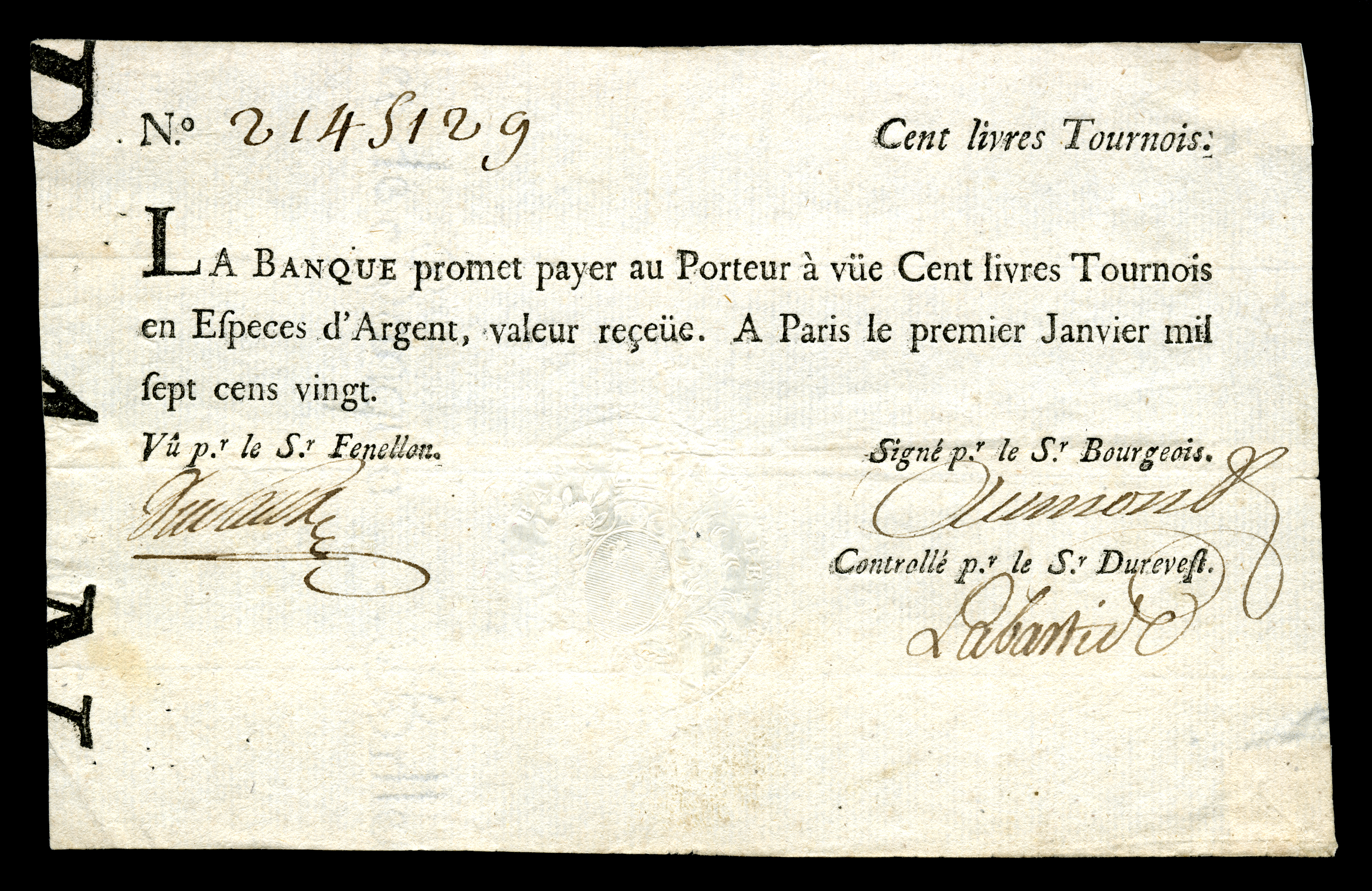

Revolutionary years
A brief timeline of the French Revolution:
- 1788: The royal treasury is empty, setting the stage for the revolution
- 1789: The Estates-General meets in Versailles, but is unable to reach an agreement on voting.
- July 14, 1789: The storming of the Bastille takes place in Paris
- August 27, 1789: The Declaration of the Rights of Man and of the Citizen is issued
- October 4, 1789: The Women's March on Versailles takes place
- 1791: The Royal Family attempts to flee Paris but is unsuccessful
- August 10, 1792: The Storming of the Tuileries takes place, leading to the downfall of the King
- December 10, 1792 – January 21, 1793: The trial and execution of Louis XVI takes place
- June 1793: The Reign of Terror begins
- October 16, 1793: Marie-Antoinette is executed
Although Louis XVI had been beheaded on January 21, 1793, coins were still issued with his portrait and retained most of the characteristics of the previous regime, including weight and denomination, however replacing the title of Louis XVI "King of the French" with a revolutionary motto instead.






Towards the end of the French Revolution, things were desperate. There was a great shortage of hard cash, due to hording and other factors. So a novel solution was rolled out: pillage. All over France churches were ransacked, and the silver ornaments of the church, as well as church bells (made from Bronze), were confiscated and melted down in order to be used for minting new coinage.
In 1792 alone no fewer than 100,000 church bells were melted down and converted into coins.
Here are some examples of "Bell money":
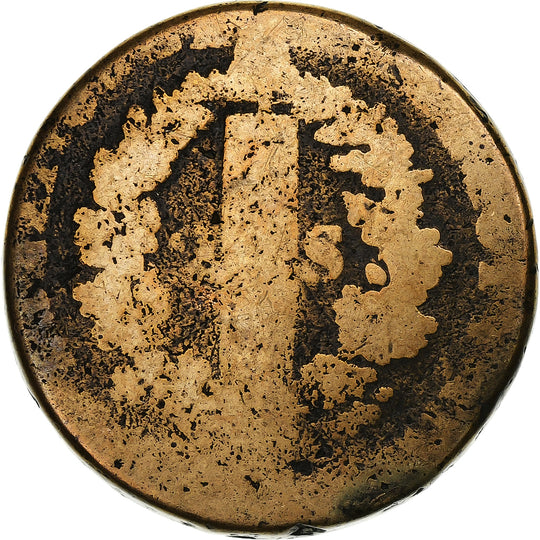
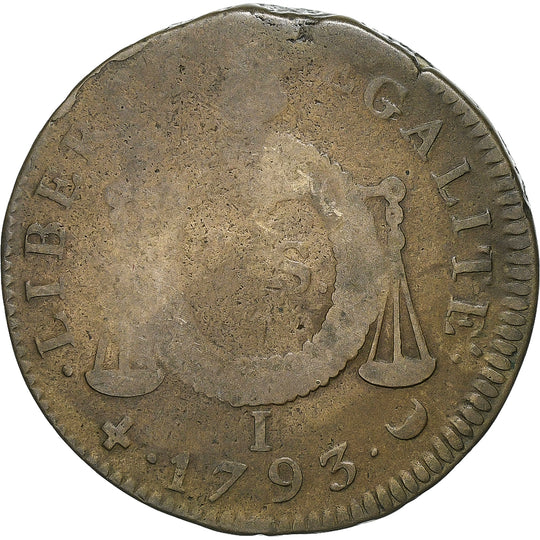
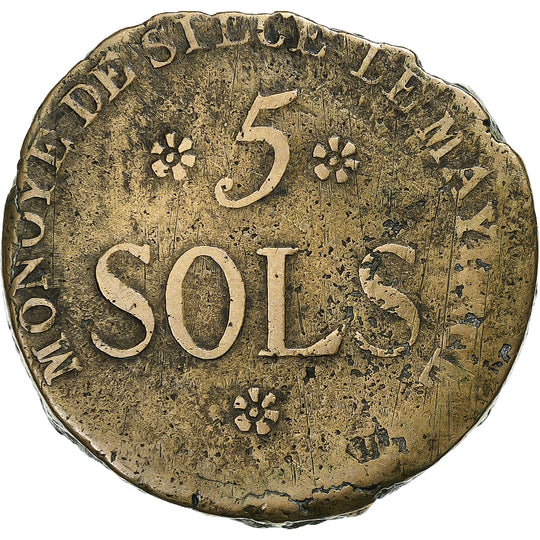
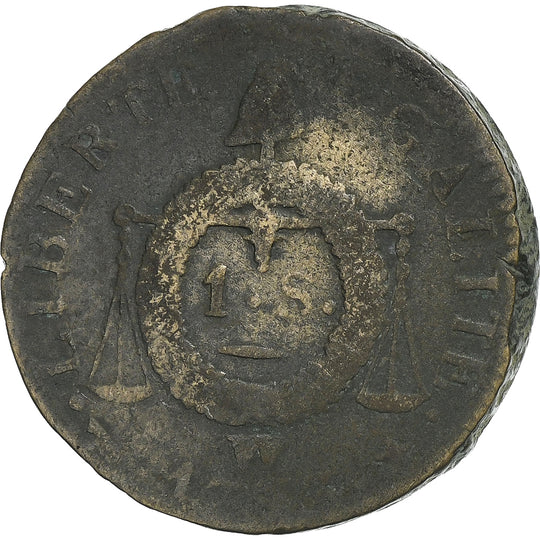
Note the yellowish color typical of Bronze, pure copper having a much more orange hue.
Banknotes in the form of the Assignat continued to be issued during the Revolutionary years. They were supposed to be essentially backed by vas confiscated properties of the Church.
But since France had to use hard cash for it's foreign trade, it quickly ran out of precious metals. So the money printer went burrrrrr in order to fill the shortfall. Again, a familiar story.
A Assignat of 25 sols, printed following the French Revolution


Note the "all-seeing eye" at the top of the banknote, which is also featured on today's US dollar bills. The "all-seeing eye" is a common part of Freemason iconography. There were many prominent Freemasons who played pivot roles in the French Revolution, including advisors to the King, authors, pamphleteers and other historical figures. To this day two of the largest French Freemasonry lodges share the revolutionary slogal of "Liberté, égalité, fraternité". It's a deep rabbit hole that I won't get into here.
An Assignat from the 1792 issued at a face value of 400 livres


The introduction of Assignats was quickly followed by the emergence of fake notes, prompting printers to look for increasingly sophisticated ways of combating counterfeiting. The authorities tried out a number of techniques: watermarks, the application of an embossed seal or identical seals on front and back, or the application of different signatures.
A 10-sous Assignat from 1792


bottom of the note reads: "Counterfeiting shall be punishable by, Informers shall be rewarded by the nation".
There was also a lot of experimentation with new coinage and currency forms.
In 1793 a 5 décimes coin was minted, supposedly it represented the regeneration of the French Nation.

Private money also circulated in the form of "Monnaies de confiance" (tokens) and "Billets de confiance", (privately bearer notes).
Here are some examples:




"Billets de confiance" - small denomination bills that were privately issued and themselves backed by large denomination Assignats held by the issuer.


Many new symbols and slogans were introduced during the Revolution, which have been depicted on French coins ever since. For example the the Gallic rooster along with the rallying cry of "Liberté, égalité, fraternité".
A coin issued much later in 1912 depicting both of these symbols


The Directory takes power
The year is 1795, the Directory takes power. During this period, the French Franc was reissued, having previously been used in France (between 1360 and 1641).
The republican authorities replaced the old monetary units of account with a rationalized decimal system based on Francs, Décimes, and Centimes
Pretty simple: 1 Franc = 10 Décimes = 100 Centimes.
This decimalization was part of a far reaching reform that also dealt with the decimalization of weights and measures in the country, as well many other edicts and revolutionary restructuring of the country.
A new 5 Franc coin depicting Hercules was issued




And various other coins under the new Franc were also issued:
5 centimes from 1795
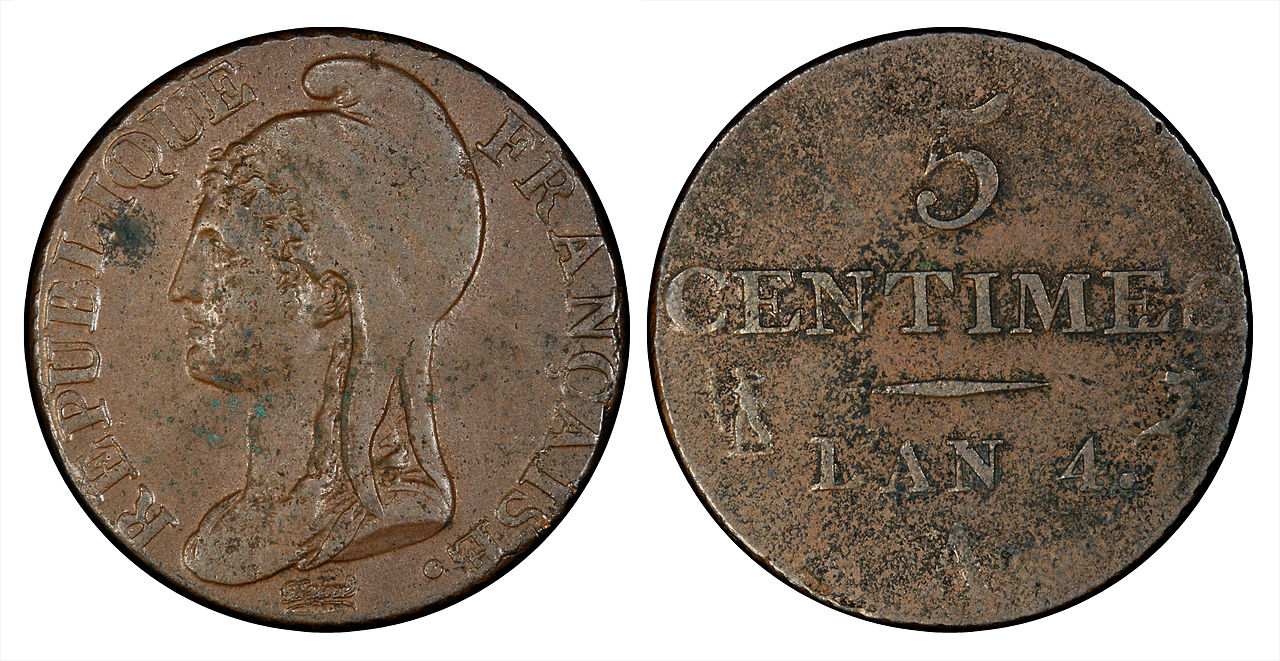

2 centimes from 1799


And Assignats contintinued to be issued, albeit under the new denominations of Francs:


The French economy was in continual crisis during the Directory. The Assignat had fallen to a fraction of its value and prices soared. The Directory then stopped printing Assignats and restored the value of the money but this caused a new crisis where prices and wages fell. This caused economic activity to slow to a standstill.
Napoleon Bonaparte
Napoleon Bonaparte seizes the reigns of power and rules from 1799 to 1814.
Napoleon Bonaparte's monetary policy included establishing the Bank of France, a central bank that would issue currency. A new age of central banking in France was born.
The bank was intended to be independent from the government, with the express purpose of promoting business rather than serving as a state fund. In 1803, the bank was given the exclusive right to issue paper money in Paris.
The 1000 Franc note, worth about 2 year’s salary for an average worker of the day.


In 1806, Napoleon accepted the canons taken from the Battle of Austerlitz to be melted down and used to make minting presses. The presses were inscribed with the words "Brass taken from the enemy at Austerlitz".
A 17th century French engraving of a screw press.
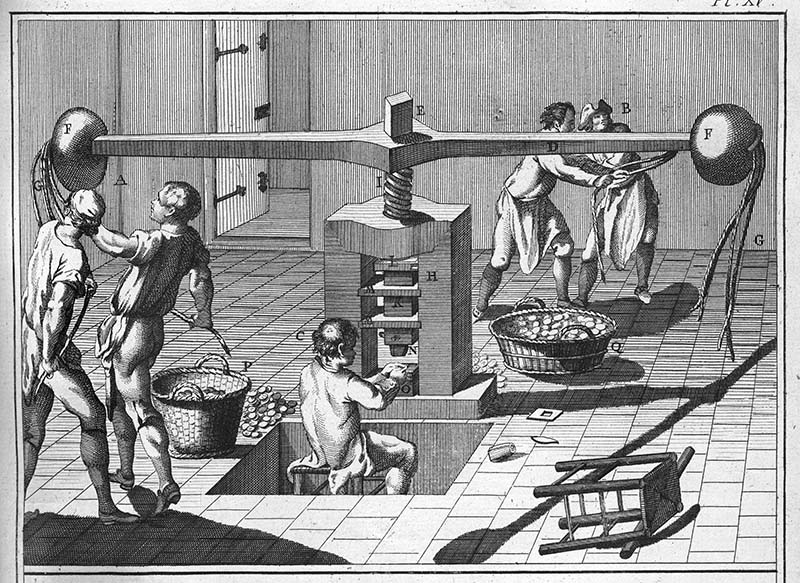

Napoleon's monetary policy helped to revive the French economy and restore confidence in the money.
A Napoleonic 1 Franc Silver coin.
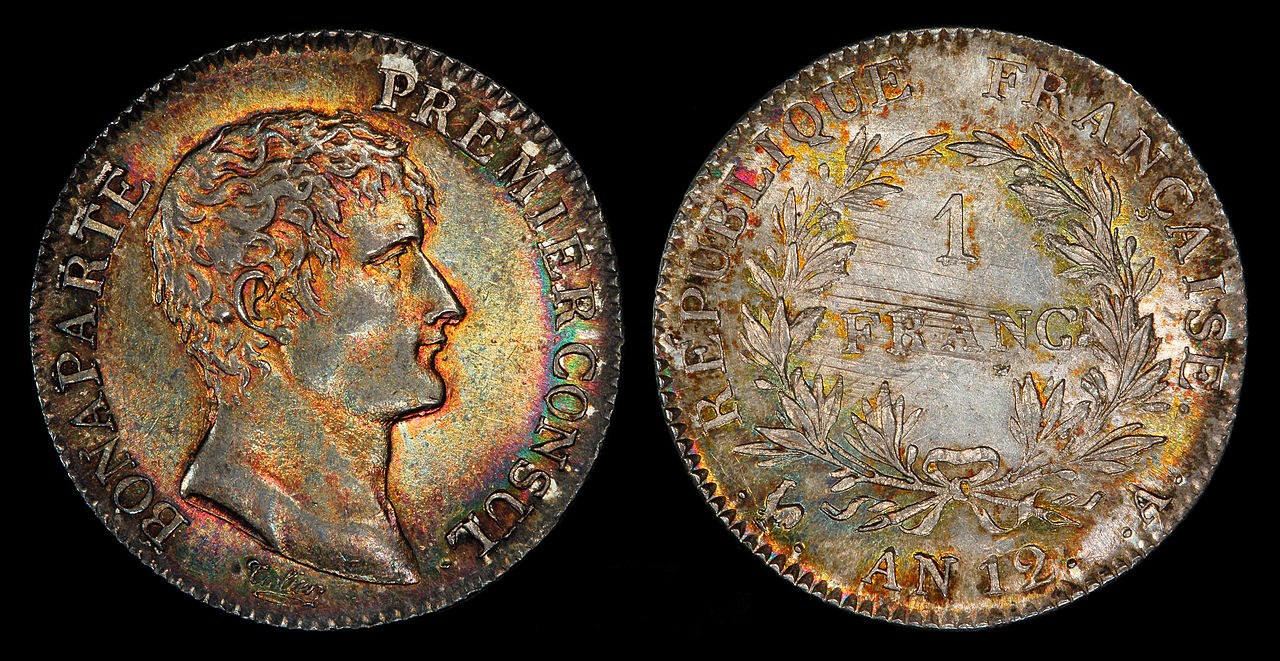

A Napoleonic 20 Franc Gold coin.


Interestingly, after the Revolution the The French Republican Calendar was often depicted on coins, starting on September 22, 1792 and increases by one year every autumnal equinox. The years were denoted by the letters "AN" (French for "year") followed by Roman or Arabic numerals.
Napoleon managed to defeat almost all of France’s continental enemies including Austria, Prussia, Russia, and Italy in most engagements. However, the economic looting of Europe stressed out the conquered territories and pushed them into rebellions against him. Additionally there was an immense imbalance in economic power between Britain and France. France may have occupied Europe, but Britain had it's empire vast behind it and could therefore mobilize more economic resources, raw materials and labour than France.
Closing out
Thanks for reading!
If you liked this write-up, sling some sats my way. If the post does well I'll keep writing them!
Also, lease take the above research piece with a pinch of salt. I've done my best to verify the details, but I may have made some mistakes! For all those history buffs out there, please let me know if you spot any errors. :-)
Sources
Images in the article are taken from various source on the internet.
And,
The above write-up is largely written by me, however I've copied and modified some sections of the text. Here you can find my sources:
https://coinfaq974389709.wordpress.com/2019/01/31/what-type-of-coinage-was-used-in-france-part-i-pre-revolution
https://numismatics.org/exhibits/france-inflation-and-revolution
https://en.wikipedia.org/wiki/French_Directory
https://en.wikipedia.org/wiki/Economic_history_of_France
https://en.wikipedia.org/wiki/French_livre
https://en.wikipedia.org/wiki/Assignat
https://en.wikipedia.org/wiki/Livre_tournois
https://en.numista.com/forum/topic4602.html
https://en.wikipedia.org/wiki/French_franc
https://www.worldcoindatabase.com/datesystems.php?page=fr
https://www.numiscorner.com/blogs/news/bell-metal?srsltid=AfmBOoohquMBzySE6cKNUdmgqiHJdtOxzaLp9jYGOyu8MDWSDFgWaft3
https://thebrunelmuseum.com/collection/french-revolutionary-banknote/
https://www.etymonline.com/word/livre
https://www.left-horizons.com/2023/12/11/napoleons-war-economy
https://blog.napoleon-cologne.fr/en/creation-of-the-bank-of-france-by-napoleon-bonaparte-2-2/
https://en.m.wikipedia.org/wiki/Libert%C3%A9,_%C3%A9galit%C3%A9,_fraternit%C3%A9
https://www.historyworkshop.org.uk/capitalism/radical-object-billets-de-confiance/
https://quod.lib.umich.edu/w/wsfh/0642292.0040.005/--counterfeiting-in-18th-century-france-political-rhetoric?rgn=main;view=fulltext
https://www.citeco.fr/en/assignat-press-french-revolution